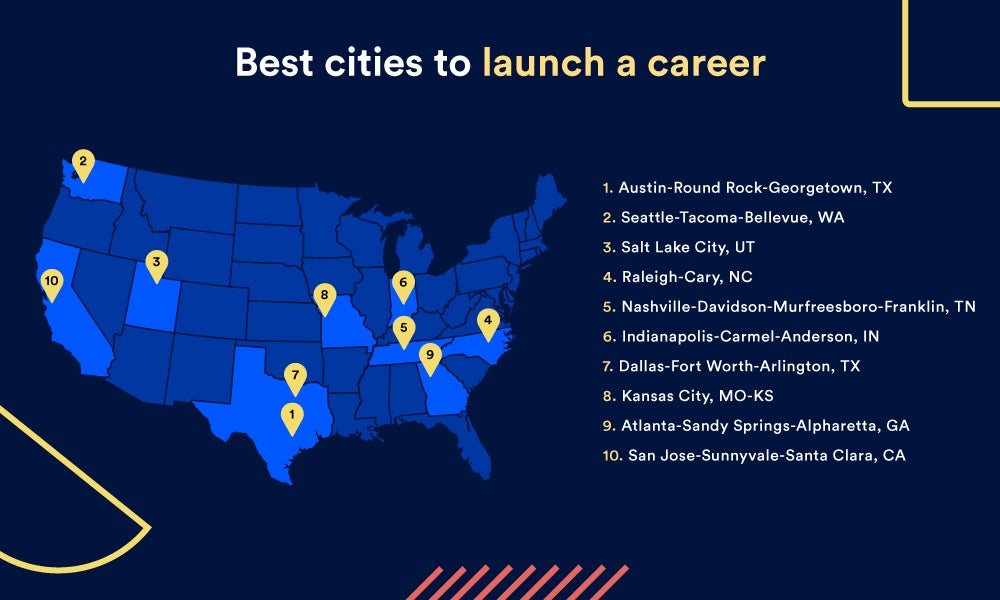10 best U.S. cities to start a career — and most are in the South

The Bankrate promise
At Bankrate we strive to help you make smarter financial decisions. While we adhere to strict , this post may contain references to products from our partners. Here's an explanation for .
Deciding where to start your career can feel overwhelming and daunting when there are so many factors to consider — from entry-level opportunities to rent prices to the availability of flexible work and other lifestyle factors.
That’s where Bankrate comes in. With many younger Americans willing to relocate for a job in the next year, we’ve created a proprietary ranking to help you figure out the best cities to launch your career.
Bankrate research finds cities that have traditionally been popular postgraduate destinations — including New York City, Washington D.C. and Los Angeles — are not the most affordable or livable options. Instead, cities like Austin, TX, or Nashville, TN, have become more cost-effective alternatives and offer a better work-life balance for young professionals. Additionally, workplace trends accelerated by the coronavirus pandemic, such as flexible or remote work, have opened up where young workers are willing to move.
The pandemic caused people to reevaluate what's important to them versus what has been pushed, because the narrative before was that you graduate and you go to one of the major cities, and you make it work with roommates. It was normalized not to be able to afford where you live. But the pandemic, and the restrictions that it came with, changed what young people find normal.— Raquel Cid, career coach and founder of Coached by Cid
Key takeaways
- A growing Southern hub for tech, the Austin metropolitan area took the top spot for Bankrate’s best cities to launch a career in 2023.
- Cities that have traditionally been popular postgraduate destinations are becoming less attractive for young professionals jumpstarting their careers. Five of the 10 best cities to start a job are in the South, including Austin, Raleigh, Nashville, Dallas and Atlanta.
- Thirty-seven percent of Gen Z (ages 18-26) and 34 percent of millennials (ages 27-42) who are employed or looking for work are willing to relocate for their careers in the next year, compared to 17 percent of Gen X (ages 43-58) and 8 percent of baby boomers (ages 59-77), according to Bankrate's job seekers survey.
10 best cities to launch a career
To find these cities, Bankrate analyzed the top 50 metro areas across three broad categories: rent prices in relation to affordability, the employment picture and quality of life. For millennials and members of Gen Z entering the workforce, here are the 10 best places to go.

Austin, TX offers a balance between work and play
Everything is bigger — and, as it turns out, better — in Texas for young professionals.
With the University of Texas, proximity to nature and outdoor activities and a lively music scene, Austin has long been a desirable place to call home. But what was once a bohemian town primarily known for its live music and colleges has transformed into one of the fastest-growing tech hubs in America, thanks to the arrival of several major tech firms, including Samsung, Tesla and Meta, in recent years.
Those big additions, alongside regional fixtures like Dell and IBM, have led to an infusion of a younger population and a new nickname, “Silicon Hills.” Over the last 10 years, tech jobs rose 62 percent in the Austin metropolitan area, surpassing gains for all industries at nearly 37 percent, according to the Austin Chamber of Commerce. Regional data also shows jobs in Austin’s tech sector make up around 17 percent of all jobs in the area, compared to 9.2 percent nationally.
While plenty of young professionals are moving there for job opportunities, that’s not the only thing on their minds. They’re also moving there to embrace the lifestyle Austin offers, from restaurants, bars and music festivals to luscious nature trails and parks.
Why these two young professionals moved to Austin, TX
When Ansley Bird, 24, graduated from Wake Forest amid the pandemic in 2021, she wasn’t optimistic about getting a job right out of college. Instead, she focused on moving somewhere with a vibrant social scene and other young professionals like her. After researching and hearing positive reviews of Austin from acquaintances, she took a leap of faith and applied for jobs in Austin.
“I didn’t really know anyone from there or who was moving there, but I kind of just fixated on it,” Bird said. “I knew that Austin was a tech city, and that kind of goes hand in hand with job opportunities, so I knew it wasn’t gonna be a bad choice.”

Her decision to focus on Austin ultimately landed her an entry-level sales job right after graduation, and she’s been able to make more career moves since moving there. Bird now works as the lead event planner for a startup dating app and says moving to Austin is “the greatest thing” she’s ever done — not just for her career but for her overall well-being, too.
“The talent here is young, so there are a lot of opportunities to accelerate your career,” Bird said. “And because everyone is young, it’s one of the most social places ever. The city makes it easy to make all new friends in a single night.”

Chloé Dwyer, 25, also had limited knowledge about Austin, TX, before moving there. But she did know two things after graduating from her higher education graduate program at Auburn University in 2022. She wanted to be within a few hours of her hometown of Dallas, TX, and wanted to work at a notable university. After applying to 40 higher education jobs across Texas and several other states in the South, she landed a job in the University of Texas’ fundraising department.
“A big draw for me is that UT is the best university in the state,” she said. “There’s so much opportunity for work, and the cost of living is doable. Right now, around 30 percent of my salary goes toward rent.”
Dwyer, a fitness lover, said one of her favorite aspects of Austin is the number of nature trails and parks around her. She’s been able to connect and make friends with others in the power-building community in Austin, a city where she barely knew anyone a year ago, and says she could see herself staying for a long time.
“The people here are so welcoming and nice,” she said. “I got here not really knowing anyone and wasn’t sure if I would stay initially, but I love it so much now. Austin sets you up for success socially, career and lifestyle-wise.”
Young professionals starting their careers are greeted with a strong job market
Experts say that millions of young adults poised to join the workforce are in luck because it’s a great time to get a job.
Mark Hamrick, Bankrate’s senior economic analyst, says that while specific sectors led by technology have seen substantial job cuts, the job market is still viewed broadly as strong. The unemployment rate is historically low, and the number of job openings is substantially higher than before the pandemic. Additionally, new data from the Economic Policy Institute reaffirms the current strength of the job market for young workers. The study found the youth unemployment rate for workers between 16 and 24 tumbled to 7.5 percent in March. While that is nearly double the national rate of 3.7 percent, it also marks the lowest level since 1953.
“Depending on their skill sets, experience and location, many aspiring workers, including those who are younger, stand a good chance of finding employment,” he said.
Career coach Cid has a few tips for young professionals wondering how to stand out in a competitive job market. Cid recommends finding unique, creative ways to showcase your current skills and develop new technical skills.
“It doesn’t have to be 10 new skills,” she said. “Just one to two technical skills that you’re good at, so that you can remain competitive in the future of work.”
Networking and building your professional brand online have also become more important than ever when trying to land your first job, according to experts.
“As a new graduate, you cannot rely on the traditional way of job searching,” Cid said. “Having a portfolio showcasing your work will increase your chances of being called for an interview or hired tenfold. It’s not expected that you will produce expert quality work, but if you put your passion and time behind it, it’ll pay off.”
Where all 50 metros rank for best cities to launch a career
-
Bankrate’s Best Cities to Launch a Career was compiled using data from a variety of sources, including the U.S. Census Bureau, the U.S. Labor Department and the U.S. Bureau of Economic Analysis. Bankrate analyzed the 50 largest metro areas in the U.S. based on several factors a young person should consider when starting their career, including: the local job market, potential for long-term career-building, affordability and lifestyle factors. Here is a breakdown of each category:
- Employment opportunity: Bankrate ranked the 50 most populous metro areas based on its unemployment rate as reported by the U.S. Labor Department in March 2023. Also from the U.S. Labor Department, we looked at the percentage change of employed area residents and local wages from March 2022 to March 2023 across the 50 most populous metro areas. This category also factored in GDP per capita and the percentage of remote workers in a metro area, per 2021 Census data. This category was given an overall weight of 55 percent.
- Quality of life: To measure a metro’s overall quality of life, Bankrate analyzed Sharecare’s Community Well-Being Index for 2020-2021 for the 50 most populous metro areas. The report ranks metro areas on access to healthcare, food and community services, including libraries and houses of worship. We also used the U.S. Census Bureau’s 2020 Diversity Index to measure racial diversity and representation for the 50 most populous metro areas. Lastly, this category is also based on average commute time, the number of arts, entertainment and recreation establishments per capita and the five-year percentage change of adults ages 25 to 34 in the 50 most populous metro areas, based on Bankrate’s analysis of 2021 Census data. This category was given an overall weight of 25 percent.
- Affordability: To account for housing costs that are relevant to young adults, we analyzed the income gap between median rent and median income across the 50 most populous metros. For median income, we used data from Census Bureau’s 2021 estimate of median income for adults ages 25 to 44. For median rent, we used May data from Rent.com. We included a 30 percent budget allocation in our calculations, since it is a well-known rule of thumb to spend around 30 percent or less of your gross income on rent. We also factored in each metro’s Cost of Living Index, as reported by the Council for Community and Economic Research, from Q2 2022. The index measures the overall cost of living in an area, with a score of 100 representing the national average. This category was given an overall weight of 20 percent.
Related Articles



